Geoscience Reference
In-Depth Information
sun
cloud
formation
new particle/
CCN formation
albedo
radiation budget
SO
2
/SO
2-
climate feedback
+ or - ?
DMS
Atmosphere
DMS
Ocean
DMSP
marine plankton
communities
Figure 11.1
The CLAW hypothesis: DMS-CCN-climate interactions. The mechanism suggested by Charlson et al. (1987) by which marine DMS
emissions from marine plankton communities inl uence climate via impacts on cloud properties.
come into contact with DMSP-lyase (Malin
et al.
1992 ,
1998). Due to the biogenic nature of DMS produc-
tion, the highest sea-surface DMS concentrations are
associated with areas of high biological activity, par-
ticularly upwelling and frontal regions and coastal
and nearshore regions. Large seasonal variations in
the occurrence of DMS are seen in temperate and
boreal regions where productivity is at a maximum
in the spring months and very low in the winter
( Kettle and Andreae 2000 ).
DMS has received a great deal of attention in recent
decades due to its inl uence on atmospheric chemis-
try and climate. Upon entering the atmosphere, it is
rapidly oxidized by free radicals including OH, BrO,
Cl, and NO
3
. This results in the production of meth-
ane sulphonic acid (MSA) and/or non-sea salt sul-
phate (nss-
aerosol effects, both scattering and absorbing incom-
ing solar radiation, and contributing to the produc-
tion of CCN, thereby modifying the planetary
radiation budget (Charlson
et al.
1987 ). This connec-
tion led to the CLAW hypothesis (named after the
four authors of the study; Charlson
et al.
1987 ),
according to which the production of DMS by phyto-
plankton may contribute to the regulation of earth's
climate (Fig. 11.1). This generated a large amount of
research, which is ongoing to this day, and remains
both highly topical and controversial.
11.1.2 Organohalogens
The oceans constitute the greatest source of volatile
halogenated organic compounds (organohalogens)
to the atmosphere, a result of the vast oceanic reser-
voir of halogens (chlorine, Cl; iodine, I; bromine, Br;
l uorine, F; Manley 2002). Organohalogens are
formed in seawater through biological and photo-
chemical processes, resulting in supersaturations in
SO
-
) via several intermediate reactions
(von Glasow and Crutzen 2004). The formation of
H
2
SO
4
makes a signii cant contribution to the atmos-
phere's natural acidity levels. Furthermore, this
marine-derived aerosol can have direct and indirect
2
4













